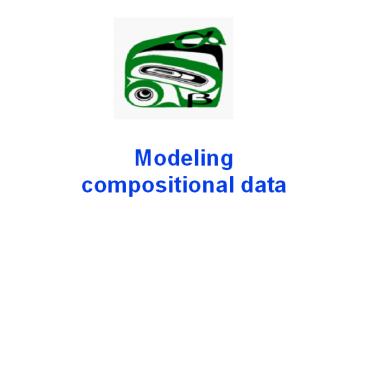Modeling compositional data - PowerPoint PPT Presentation
1 / 30
Title:
Modeling compositional data
Description:
compositional data Some collaborators ... Peter Challenor Markov random fields: Finn Lindstr m Wavelets: ... PowerPoint Presentation - Compositional data Author: NRCSE – PowerPoint PPT presentation
Number of Views:92
Avg rating:3.0/5.0
Title: Modeling compositional data
1
Modeling compositional data
2
Some collaborators
- Deformations Paul Sampson
- Wendy Meiring, Doris Damian
- Space-time Tilmann Gneiting
- Francesca Bruno
- Deterministic models Montserrat Fuentes, Peter
Challenor - Markov random fields Finn Lindström
- Wavelets Don Percival
- Brandon Whitcher, Peter Craigmile, Debashis Mondal
3
Background
- NAPAP, 1980s
- Workshop on biological monitoring, 1986
- Dirichlet process Gary Grunwald, 1987
- Current framework Dean Billheimer, 1995
- Other co-workers Adrian Raftery, Mariabeth
Silkey, Eun-Sug Park
4
Compositional data
- Vector of proportions
- Proportion of taxes in different categories
- Composition of rock samples
- Composition of biological populations
- Composition of air pollution
5
The triangle plot
1
Proportion 1
(0.55,0.15,0.30)
0
0
Proportion 2
1
1
0
Proportion 3
6
The spider plot
0.2
0.4
0.6
0.8
1.0
(0.40,0.20,0.10,0.05,0.25)
7
An algebra for compositions
- Perturbation For define
- The composition acts as a zero, so .
- Set so .
- Finally define .
8
The logistic normal
- If
- we say that z is logistic normal, in short Z
LN(m,S). - Other distributions on the simplex
- Dirichlet ratios of independent gammas
- Danish ratios of independent inverse Gaussian
- Both have very limited correlation structure.
9
Scalar multiplication
- Let a be a scalar. Define
- is a complete inner product space, with inner
product given, e.g., by - N is the multinomial covariance NIjjT
- j is a vector of k-1 ones.
- is a norm on the simplex.
- The inner product and norm are invariant to
permutations of the components of the
composition.
10
Some models
- Measurement error
- where ej LN(0,S) .
- Regression
- Correspondence in Euclidean space
- xj x g uj
centered covariate
compositions
11
Some regression lines
12
Time series (AR 1)
13
A source receptor model
- Observe relative concentration Yi of k species at
a location over time. - Consider p sources with chemical profiles qj. Let
ai be the vector of mixing proportions of the
different sources at the receptor on day i. - Q LN, ai indep LN, ei zero mean LN
14
Juneau air quality
- 50 observations of relative mass of 5 chemical
species. Goal determine the contribution of wood
smoke to local pollution load. - Prior specification
- Inference by MCMC.
15
Wood smoke contribution
95 CL
50 CL
16
Source profiles
(pyrene)
(benzo(a))
(fluoranthene)
(chrysene)
(benzo(b))
17
State-space model
- Space-time model of proportions
- State-space model
- zj unobservable composition LN(mj,Sj)
- yj k-vector of counts Mult(
- Inference using MCMC again
18
Stability of arthropod food webs
- Omnivory thought to destabilize ecological
communities - Stability Capacity to recover from shock
(relative abundance in trophic classes) - Mount St. Helens experiment 6 treat-ments in
2-way factorial design 5 reps. - Predator manipulation (3 levels)
- Vegetation disturbance (2 levels)
- Count anthropods, 6 wks after treatment. Divide
into specialized herbivores, general herbivores,
predators.
19
Specification of structure
- ? is generated from independent observations at
each treatment - mean depends only on treatment
20
(No Transcript)
21
(No Transcript)
22
Benthic invertebrates in estuary
- EMAP estuaries monitoring program Delaware Bay
1990. 25 locations, 3 grab samples of bottom
sediment during summer - Invertebrates in samples classified into
- pollution tolerant
- pollution intolerant
- suspension feeders (control group mainly palp
worms)
23
- Site j, subsample t
- qj CAR process
24
(No Transcript)
25
Effect of salinity
26
(No Transcript)
27
(No Transcript)
28
(No Transcript)
29
(No Transcript)
30
(No Transcript)































